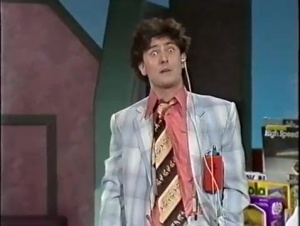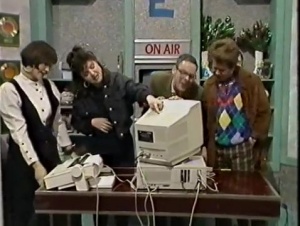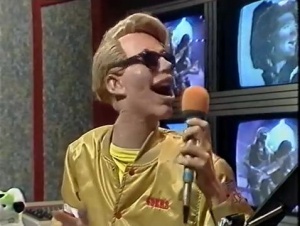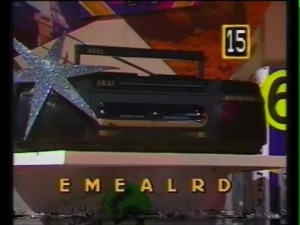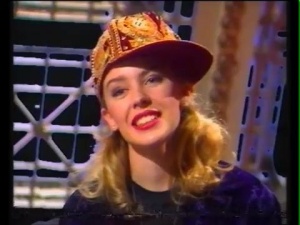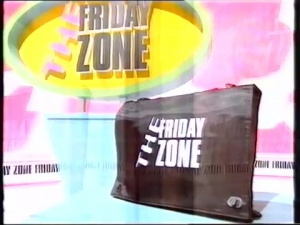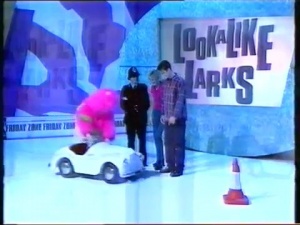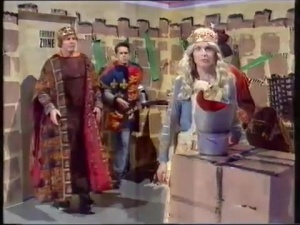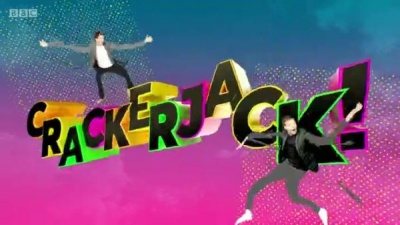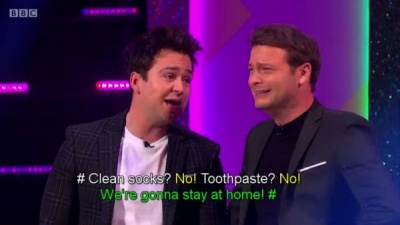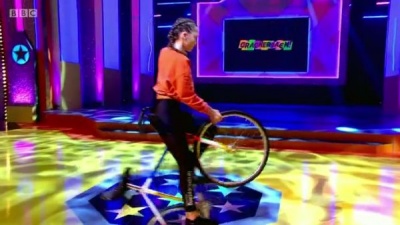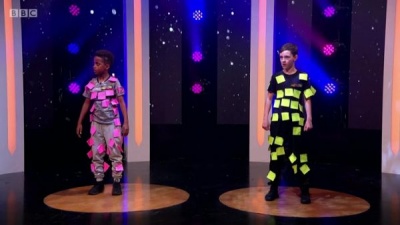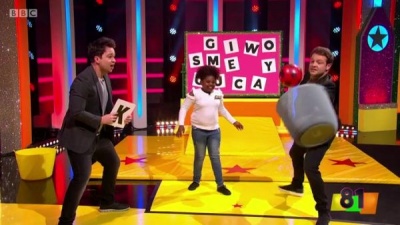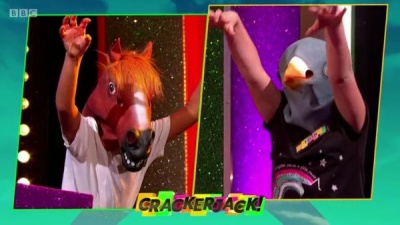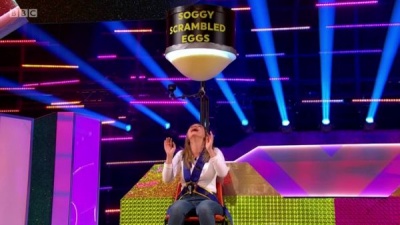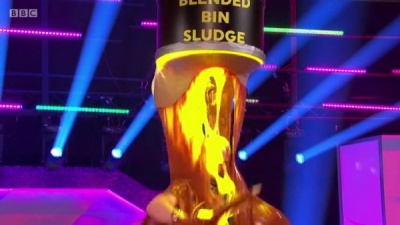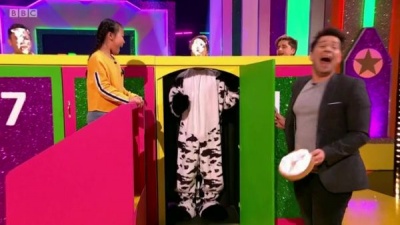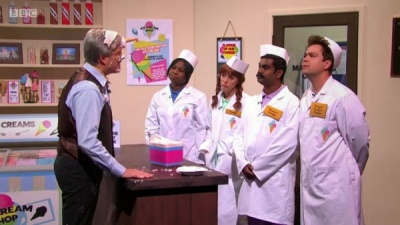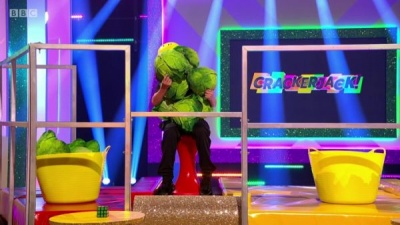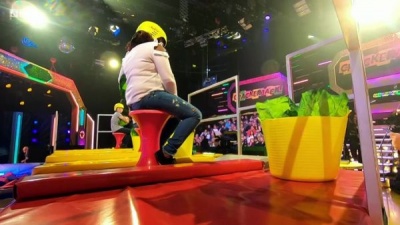Weaver's Week 2020-02-16
Last week | Weaver's Week Index | Next week
The death of Caroline Flack was announced yesterday evening. We'll have a full obituary for the Love Island presenter, Strictly Come Dancing champion, and TMi host next week.
Contents |
The road from Crackerjack to Crackerjack!
As we found last week, Crackerjack came off the air at the end of 1984. The journey to its return in 2020 was long and winding.
The mixture of comedy and fun from the 1970s had already been dismembered, the comedy elements had been surgically removed during 1980 and 1981. The funny stuff flew off to a children's department outpost on BBC2, and merged with another veteran show, Play Away. The result was Fast Forward, a sketch show with Floella Benjamin, Nick Wilton, Joanna Monro, and the voice impressions of Rory Bremner. Three series of new comedy emerged between 1984 and 1988, the last two shown on mainstream CBBC.
Pop music, which had suffocated Crackerjack in its closing years, was sent back to Cheggers Plays Pop, the last series of which went out on Fridays in 1986. Gunge appeared in the most unexpected places: semi-serious competition Spytrap featured slop for the weekly winners. But for a couple of years, Friday was mostly spent with Roy Castle and his Record Breakers, and repeats of Grange Hill from the spring.
What's All This Then? was the first effort to bring back the free-wheeling Crackerjack ethos, in autumn 1987. A crew of comedy players – Steve Blacknell, Matthew Devitt, Gideon Escott, Robert Harley, Caroline Leddy, and Carla Mendonca – were cast away on a space adventure. For reasons of narrative convenience, they beamed up special guests – the first episode featured "the galactic Rick Astley, and the incredibly cosmic Lenny Henry". Hook the kids in with their fave stars, and keep us watching with comedy.
The effect was a magazine show, similar to the ones on Saturday morning. The best Saturday shows – like Saturday Superstore and Number 73 – use their setting lightly, they don't need to keep reminding us of the writers' conceit. What's All This Then? took its out-of-this-world setting more seriously, and suffered as a result.
Most of the same crew returned the following year for The Satellite Show. Producer Christopher Pilkington had learned from last year's wobbles, and gave us a more coherent programme. The setting, BBE Television, was a fledgling satellite station, with an overwhelming (but mostly absent) boss, and a bunch of characters backstage. A situation comedy was played out in brief snatches across the show.
The main focus was "CD", an animatronic character in the style of Max Headroom. He'd tell jokes, and interview the stars – and they could get some very big names, none more 1988 than a live link-up with the cast of Neighbours. There was a limited amount of pop, and an interruption from Dooby Duck. And there was a game to interest us, Name That Thing!
Robert Harley plays Bob Hopeless. He shows a series of still pictures, and challenges three teams to buzz in and name that thing – but only if it begins with that week's letter. "Buzz if it does, don't if it doesn't." Played at super-high-speed, it's easy to play, surprisingly difficult to play well.
The winners are then asked to name nine more things, and form an anagram out of the letters. Any relation to the Countdown conundrum is accidental, you wouldn't catch Richard Whiteley showing people a picture of a goldfish. For the second series, they chopped the anagram down to seven letters, and made it slightly easier.
Comedy changed for the second series, too – out went the scripted back-office banter, in favour of a loose collection of sketches in the style of Fast Forward. Some of the ideas – not least a badly-dubbed soap opera – would have been viable on grown-up telly. There was still some pop on The Satellite Show, and sometimes guests went up to the AAA1 stars of the day. Kylie Minogue? That's out of this world!
For all its star power, The Satellite Show never quite felt at ease with itself. The animatronic host fell into that uncanny valley – clearly not human, but not clearly inhuman, and looked entirely naff even by the standards of the time. The uneven mixture of items didn't help – extended sketches and a serial rubbed shoulders with filmed reports from Bruno Brookes at the National Youth Disco Dance Championships.
ITV hadn't rested on its laurels, they'd bought up Stu Francis as soon as he became available, and he hosted Crush a Grape. It was Crackerjack on commercial telly, an equal mix of comedy and games and pop and gunge. Later in the decade, Knightmare brought the competition, Fun House and Finders Keepers brought gunge and mayhem. But Crackerjack was never likely to return on the other side.
Hangar 17 was another BBC effort, running for three series in the early 1990s. Mickey Hutton hosted from a youth club in the studio, with performances from C-list pop groups and dancing contests in the audience. Comedy had shifted off Friday nights, to shows like Rick Adams' Sunday morning wonder For Entertainment Only. Meeting of The Pineapple Chunks fan club to order please... oh, just this column.
It's Friday, it's four o'clock
The Friday Zone was perhaps the closest effort to a new Crackerjack. It ran for the first few months of 1997. Josie D'Arby and Chris Jarvis moved over from the CBBC presentation studio, Peter Simon from Run the Risk was an experienced hand. Emma Lee and Steve Rock were at the high point of their careers, Debra Stephenson and Dominic Wood just starting on theirs.
The show was live – even Crackerjack had been taped since the 1960s – and used its time to good effect. Children were plucked from the audience to build part of the studio set: if they messed it up, they'd look silly. Other audience folk would take part in simple challenges, such as flap a paper fish across the studio by waving a mat behind it. Viewers at home wrote in with their jokes, and with their teachers who look like famous people.
The Friday Zone was primarily comedy, one-liners and longer sketches, with some jokes running through the episode – and a motif recurring through the series about Dominic Wood being young and invisible to the older performers. Each episode of The Friday Zone ended on the set built by children from the audience, where the cast would perform a long sketch – all absolutely live. No danger of The Goes Wrong Show nicking ideas from here, everyone was on cue and line-perfect.
It was an impressive show, very much of its time, and must have been quite expensive to produce. With yet more budget cuts hitting children's telly, decent but unrepeatable shows like The Friday Zone were first to go. Anna Home, a former Controller of Children's Programmes, had noted in her memoir that nothing like Crackerjack had ever caught on, and maybe it was time to try something else.
So the elements went their separate ways, the threads of light entertainment were frayed and unwound. Pop went to The Top 40 Show and The Playlist. Gunge was passed from Dave Benson-Phillips to Dick and Dom's Bungalow. Comedy poured into the cracks between the programmes, thanks to Ed and Oucho, then Hacker and all his sidekicks. Games, this column has covered in detail.
Back in the early aughts, Blue Peter had some entertainment shows on Friday, concentrating on pop and fun and spontaneity. Producer Richard Marson remembered from his own youth how Crackerjack had this huge stack of prizes, and that brought excitement: will the winner pick the prize you would have picked? He found the rights for Double or Drop were available for a very reasonable price, and bought up the game for a few weeks.
Ten years later, Dick and Dom brought Hoopla to our screens. Set in a family circus, the show included variety performances – no pop stars, but physical acts and magic. And there were games and stunts, enough to excite the thin-skinned killjoys at OFCOM.
Sam and Mark's TMi Friday began on the CBBC channel in autumn 2010, a studio-based version of their Saturday show. It morphed into Sam and Mark's Big Friday Wind-Up in 2011, involving copious amounts of gunge, hidden camera stunts, gunging of fathers, entertainment and pop acts, a few contests here and there, and did we mention there was some BBC gunge? Wind-Up was one of the flagship shows on the CBBC channel: eight series, three Children's BAFTAs, and a generation knew that Friday night meant Sam and Mark meant entertainment.
All of which brings us to the new series of Crackerjack!. Sam and Mark acknowledge the show's heritage in their opening announcement, it always ends...
"It's Friday"
"It's six o'clock"
"It's Crackerjack!!"
Then a re-make of the Stu Francis-era opening titles: we don't have the cartoon animations of Stu and his gang, but modern photo-montage animations. They've used the whole title song, including the middle eight and instrumental break: so many other shows would just chop to the chorus.
Sam and Mark give a very brief comedy routine. It might include a comedy crosstalk song. Witty, snappy, and immaculately performed, Sam and Mark briefly become the vaudeville movie stars from the 1940s. The Marx Brothers? Burns and Allen? Abbott and Costello? No, mate, Sam and Mark. These guys are on your telly set, performing an original comedy routine. It might feel like something from your great-grandparents' youth, but it's fresher than Fresh 'n' Fly.
The vaudeville theme continues with a physical performance. A dancer with a hoop, or a man who absorbs himself into a large bubble. Or we might get someone turning tricks on a bicycle, almost a shot-for-shot recreation of a routine from 1984.
And now we're into the various games they play. This being a game show column, we should probably discuss the games in some detail.
Stickly Come Dancing. Two members of the audience have come forward, and have had 50 (fifty) sticky notes pasted around their body. On the signal, our contenders will start dancing, and hope to dislodge the notes from their body. Whoever has the fewer sticky notes on their body will be the winner.
Take A Letter. You'll remember this from the Stu Francis era, or from last week's column. Child, board of letters, remove one letter, bring it back to Sam (or Mark). On the back, there's either a question for the child to answer. Or there's "Stunt!", which is brought on stage by Mark (or Sam). 90 seconds each, most points wins.
One point of difference here. Remember how Stu Francis got himself stuck behind a Crackerjack clipboard, containing the questions and stunts? Sam and Mark do away with that faff, by writing the questions on the back of the letter. Change is not always a bad thing.
Snap and Whack Our players are given three animal masks, and a thick divider so they can put on the masks in secret. On cue, they'll rise above the divider and roar at each other. If the masks match, our players race to a central buzzer, first to hit it scores a point. Touch the buzzer when the masks don't match and a point goes to the other player. First to three wins.
Then there's a comedy sketch, from some of The Crackerjack! Players. Freshly-written, never before seen on television, pure physical comedy.
Splatterjack is played next most weeks. It's a bit like Get Your Own Back, as the contestants have invited along someone they know to get gunged. These adults sit on seats, beneath balloons carrying yucky coloured gunge. Atop their seat is a sharp blade, which will puncture the rubber balloon and let the gunge out.
The players will be asked estimation questions, and the closer to the right answer will get three seconds to pump up their adult. First to break the balloon wins the game, and gunges their grown-up. As if that wasn't enough fun, there's always the chance that the sharp blade isn't quite sharp enough, and they might have to use a hand-held prodding object to get the gunge.
Crackerjack! is comfortable showing how it's made. It's a television programme, so we'll get to see cameras move across the studio, and we'll get to see things go wrong.
Another game might appear in this slot. Piedentity Parade asks its contestants to remember which fancy dress bodies are associated with which heads. After we've seen the bodies, the heads (and associated bodies) switch places down the line.
In turn, the players pick a body from the array of cards. Our player chooses the person who has that costume, then hops on a set of wheeled steps. Sam (or Mark) move them forward along the line, and our player puts a pie in the victim's face. Only then do we see if they're right.
Encouraging children to put pies in the face of famous people? And why not. It's classic light entertainment. And there's an Easter egg for the parents: a wholly unexpected appearance by the Blockbusters theme tune.
Straight after this, Sam and Mark move on to the next item, an observation quiz that they call WATCH IT!. Three children will watch a comedy sketch, and will answer questions on that sketch. And if the quiz isn't of interest, then you've another top notch comedy sketch to watch.
Another item appears here. It might be a sketch involving the week's special guests, or a performance by a CBBC-friendly pop group. There aren't many differences between Crackerjack of 1979 and Crackerjack! of 2020: one is that the pop performance is no longer a regular item. The modern CBBC channel targets children aged 6-12, and provides plenty of pop coverage on The Playlist and elsewhere. A standalone appearance on Crackerjack! is no longer required, and they can use the time to put in something better.
Such as the Double or Drop finale. It's the great Ejector Seat revival we never expected to see, yet somehow knew would be on children's telly. The winners of the three games take part, and answer general knowledge questions as their stool moves backwards along a conveyor belt.
They can shout "cabbages!" to stop the belt, but will have to hold some more cabbages through the entire game. Drop a cabbage, or fall off the end of the belt, and you're out of the game.
Where does the "double" element come in? Each correct answer doubles the value of the prize: from a roll of loo paper, to a puzzle cube, to some mystery putty. Lose the main game and you'll still get to keep this prize – and a giant Crackerjack! pencil. Ian Kirkby, who plays The Prize Guy, has taken inspiration from Peter Glaze.
The winner still gets to pick their major prize from the Crackerstack of amazing prizes, and everyone joins in the goodbye wave (and a burst of Cracker-oke, if they need to fill for time).
Steve Ryde and Jamie Wilson are the men behind this show: the former worked on Dick and Dom in Da Bungalow, the latter knows CBBC heritage inside out, as shown on the wonderfully warm Hacker's Birthday Bash a few years ago, and Saturday Mash Up more recently. Sam and Mark prove themselves as two of the best presenters they've got on CBBC. Credit also to the rest of the Crackerjack! players, Paris Atkins, Kate Malyon, Inel Tomlinson, and Madhav Vasantha.
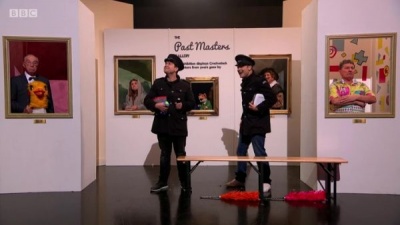 A nod to Crackerjack of the past, with Bernie Clifton, Jan Hunt, Lord Basil of Brushford, Don MacLean, and Stu Francis.
A nod to Crackerjack of the past, with Bernie Clifton, Jan Hunt, Lord Basil of Brushford, Don MacLean, and Stu Francis.
Quite honestly, they could do far worse than take the best bits of this series, package them up for Saturday night BBC1, and stick them out one evening. It's warm, family-friendly entertainment, made from a love of amusement and a place of shared humanity. It's lovely telly, and fresh every week. It's set a high bar for Ant and Dec's resumed Takeaway series.
Best new show of 2020? In the best possible way, we hope there's something even better to come. Producers, your challenge is to beat this.
In other news...
Did you work out the anagram from The Satellite Game? We got no further than "RED", we're hopeless at word puzzles.
Take Me Out has finally been taken out. The most recent series of Paddy McGuinness's dating show had sat on an ITV shelf for almost two years, and it's no surprise that it won't be renewed. We are surprised that What Would Your Kid Do? has also been consigned to ITV History: the non-judgemental parenting show was perhaps better in its midweek slot. Also in the dumper: Through the Keyhole and make-your-own-prize show This Time Next Year.
Something new this week. Corner Shop Cook-Off (BBC Scotland, Wed) challenges Gary MacLean and a guest to make a three-course meal for little money. We've two episodes of Jon Snow's Very Hard Questions (More4, Wed), where clues cost points. BBC II!'s Don't Scream gets a spin on BBC1 (Mon), and Fight Dirty appeared online yesterday. A new run of Breaking the News (Radio Scotland, Fri).
Saturday Night Takeaway returns next Saturday (ITV, and VM1 on tape delay), and it's the battle rounds of The Voice (so don't bother). Pointless Celebrities goes back to the 70s.
Photo credits: BBC, BBC Children's Productions.

